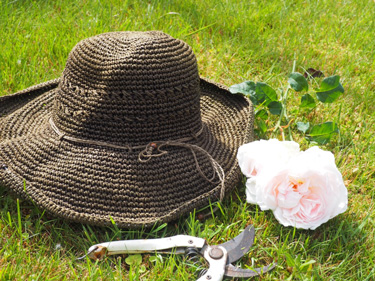Be a sun smart gardener
As a child of the sixties and seventies, I am of that generation who played dangerously in the sun.
Responsible parents would supply us hats and what we called Sun Tan Lotion, all the while reinforcing with their own sun-worshiping behaviour and comments like ‘how lovely and brown you are’, that sun kissed skin was highly desirable. Sun blocking swimwear had yet to be invented. As teenagers we lay on the sand frying in Johnson’s baby oil. This was no time to concern ourselves with premature ageing or skin cancer. Irreversible skin damage was the last thing on our minds.
The sun smart message got louder and clearer over the years, and I’ve been a stickler for sun protection with my children. But still, for a lover of gardening and other outdoor pursuits, I remained far too haphazard with my own slip-slop-slap. And then ten years ago my mother was diagnosed with melanoma. A deep chunk cut from her lower leg serves as a reminder of how lucky we are to still have her. Increasingly, as we age, we baby boomers are having skin cancers removed. Skin checks are becoming as important as going to the dentist - arguably more so since they might save our lives.
Gardening is a healthy pursuit in so many ways, but it is also an outdoor pursuit. When planning for a morning in the garden I will slap on the factor fifty, especially on the back of my neck, plus a wide brimmed hat and a long sleeved shirt with a collar.
But oh so distracting is a much loved garden. All too often I will nip out to pick a rose or check on my seedlings and end up in the sun for too long. In summer, a fair-skinned person can burn in as little as 11 minutes. While men’s melanomas are most commonly on their backs, 40 percent of women’s melanomas are on their legs. How often do we gardeners cover up everything except our legs?
On summer weekends I’ve realised that indoor tasks are most sensible when the sun is at its peak. Far better, and more pleasant, to be out there at the end of the day or at sunrise. Another option is to devote time to the shady parts of the garden when the sun is at its peak. The Sunsmart website (sunsmart.org.nz) tells us that the critical period for sunburn from September to April is between 10 am and 4 pm. And its easy to forget that it is not just on blue sky days that we are at risk. UV penetrates on overcast days too, and a cooling breeze does nothing to prevent the suns damaging effect on our skin.
Because of holes in our ozone layer, we have the most extreme levels of cancer-causing UV down here in the Southern Hemisphere. Skin cancer is the most common cancer affecting New Zealanders. The rising levels of melanoma among the older generations should be enough proof to all that covering up is a very good idea.
So, it’s time to bring out the sun umbrellas and move outdoor furniture under trees in time for another great kiwi summer.
Creating shade in the garden
The loveliest shade in the garden is provided by trees, but while you wait for trees to grow, or if your outdoors is too small to plant them, there are other ways to create summer shade.
Sun umbrellas are instant and versatile. Their price usually reflects the quality of the fabric, with modern UV-resistant fabrics lasting indefinitely. Fixed fabric awnings may be rolled back to let the sun through in winter. Shade sails are made from high quality marine-grade materials in a choice of colours and various weaves depending on the degree of shade or weatherproofing required. Lightweight collapsible tent structures (fabric ‘gazebos’) might not last forever, but they’re ideal as extra shade cover for summer parties and look great bedecked with flowers.
Another option is to build a permanent asset for your garden in the form of a pergola or gazebo. Gazebos are generally free standing structures which, as well as providing shade, are a focal point of the garden. Large gazebos have room for a table and chairs, smaller ones have seating around their perimeter.
Traditionally a pergola was also stand-alone structure, a shaded passageway between one garden room and another. Today’s pergolas are an extension of the indoor living area. Adorned with climbing plants they are a great way to link house and garden. Plants with pendulous fruits and flowers such as grapes and wisteria are particularly effective, although you have to be prepared to put up with the bees they attract or fallen flowers littering your patio. However, a deciduous climber can work brilliantly when if you need shade in summer but want to let the sun through in winter.
Make sure your pergola is built strong enough to support your chosen plants (old wisterias have been known to bring down an entire verandah) and allow enough height for flowers and foliage that hang down from above. A pergola that’s too low feels oppressive and cramped.
Climbing plants for pergolas
Evergreen
Herald’s Trumpet (Beaumontia) (subtropical),Clematis paniculata, Tecomanthe speciosa, Mandevilla Alice du Pont (subtropical), Star jasmine (Trachelospermum)
Deciduous
Clematis Montana, Clematis Hybrids, Flame Vine (Pyrostegia), Ornamental grapevine, Trumpet vine (Campsis), climbing roses, Wisteria
Scented
Climbing roses, Wisteria, Star jasmine (Trachelospermum), Easter Herald Trumpet (Beaumontia), Golden Chalice Vine (Solandra maxima)
Fruiting
Grapes, kiwifruit, passionfruit, climbing beans
Trees for shade
Robinia, Gleditsia, Ginkgo, Jacaranda, Melia, Silk Tree (Albizzia), Pepper tree (Schinus), palms
For smaller gardens
Japanese maples, flowering cherry (Prunus), flowering crabapple (Malus), Kowhai (Sophora), tree ferns
3-Dec-2015



